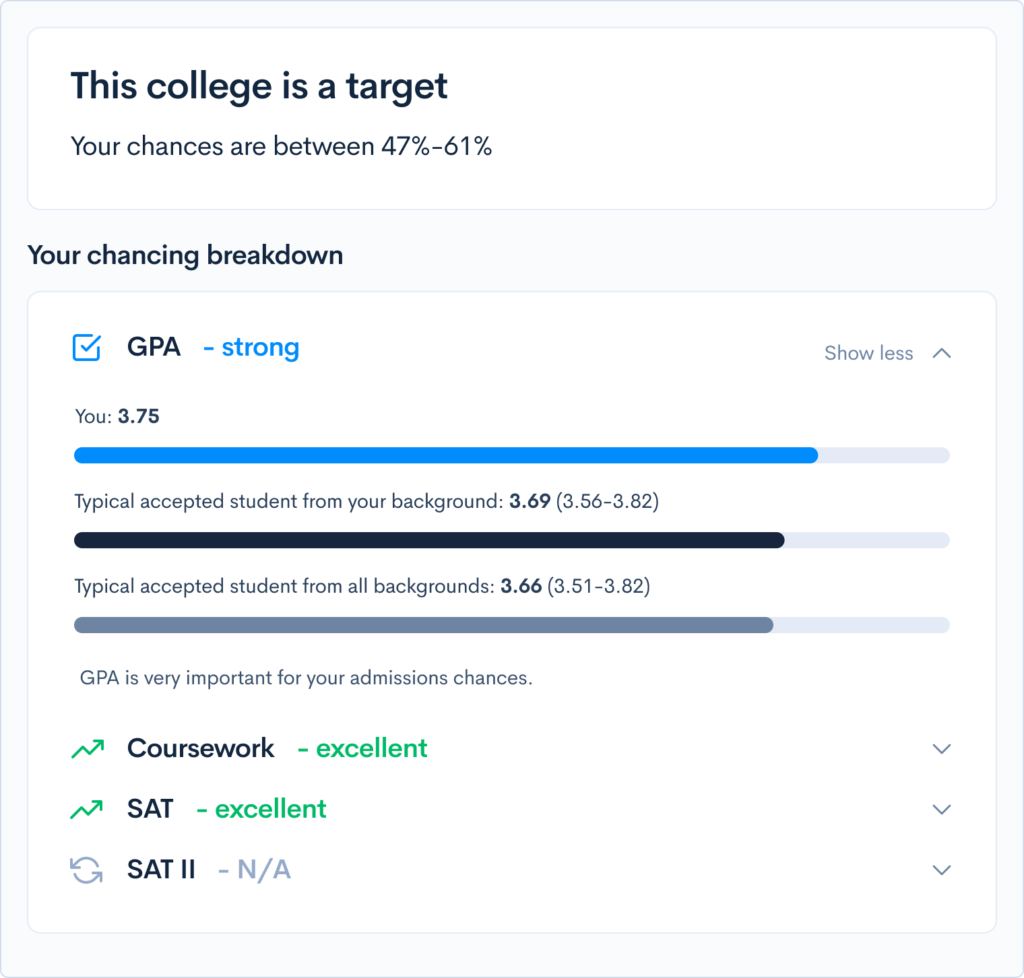What is Duke University Known For?
What’s Duke known for? Basketball, obviously. But Duke University is also one of the nation’s most prestigious modern research universities. Unlike institutions such as Harvard, Yale, and Princeton—founded in the 1600s and 1700s—Duke was established in 1838 as Trinity College and didn’t become Duke University until 1924. Today, Duke has a reputation for its competitive admissions, excellent academics, championship-level athletics, and global presence—and is known as one of the finest institutions in the South, if not the country. Location: Durham, NC Undergraduate Enrollment: 6,523 Acceptance Rate: 6% Middle 50% SAT: 1500-1570 Middle 50% ACT: 34-35 Duke is consistently ranked among the nation’s best universities; however, it’s often thought of as a “safe target” school for students hoping to gain admission into a higher-profile Ivy League school. That said, Duke is commonly thought to use yield protection, a practice in which colleges reject or waitlist excellent candidates they believe will get accepted at more prestigious institutions. Despite this, it doesn’t use yield protection as rigorously as similarly positioned schools, such as Washington University in St. Louis. Because Duke is often seen as a “safe target” school, it places particular emphasis on its 150-word “Why Duke” essay. It also weighs admissions interviews more than other institutions—its weight at Duke is about 10% compared to 3-4% at other colleges. What is Duke University known for? Its academic philosophy encourages interdisciplinary scholarship outside of the classroom. Consequently, Duke provides a rich atmosphere for students to explore the world around them—from academics to athletics to art. Duke is divided into two undergraduate schools: Roughly 80% of Duke undergraduates are enrolled in the Trinity College of Arts & Sciences, and the other 20% are part of the Pratt School of Engineering. Every Duke student takes classes at the Trinity College of Arts & Sciences—it is the core of a Duke education. Through these courses, students learn to balance tradition with innovation, think critically, consider issues from different perspectives, analyze thoughtfully, and communicate effectively—all skills that transcend academic fields and career paths. Duke University offers 63 majors, 61 minors, and 23 certificates—majors cover a broad spectrum of interests ranging from African & African American Studies to Visual Arts. Over 80% of Duke undergraduates pursue more than one major. The Pratt School of Engineering’s 4+1 program is a popular option for undergraduates. The 4+1 program enables engineering students to complete a bachelor’s degree and a master’s degree in as little as five years. The program is available for every master’s program offered by Pratt. Program II is unique to Duke. Program II is not a typical major; rather, it’s an individualized degree path that allows students to explore a specific area of scholarship—often this is an area of interdisciplinary or emerging knowledge not available in existing majors. Students work with a committee to develop coursework that culminates in either a Bachelor of Science or a Bachelor of Arts degree. What is Duke known for? Basketball! The Blue Devils are one of the most celebrated and winningest basketball teams in the country—they have won five national championships and appeared in 11 championship games. Famous Duke basketball players who have gone on to illustrious NBA careers include: While Duke’s men’s basketball team steals the spotlight, their women’s golf team also has a history of success. They won their 7th NCAA championship in 2019 and numerous students have gone on to play professionally. Greek life plays a considerable role on campus at Duke, and about one-third of all undergraduates join a fraternity or sorority. The school’s 24 fraternities and 18 sororities are important contributors to the college’s social scene. In recent years, the university has moved to minimize the importance of Greek life in Duke’s social scene, albeit with mixed results. There are plenty of opportunities outside of academics and athletics at Duke. The school is home to hundreds of student clubs and organizations. Some favorites include: [amp-cta id="9459"] Basketball permeates nearly every aspect of life at Duke and takes center stage among its traditions—its games against rival UNC (located just eight miles down the road) are among the biggest moments of the year. Duke and UNC have squared off on the court for almost 100 years and face off at least twice a season. UNC’s men’s basketball team is third in terms of all-time wins, and Duke’s team is right behind them as number four. Off the court, Duke’s best-known tradition is Last Day of Classes (LDOC), a campus-wide party featuring music, arts, and socializing, which occurs on the last day of class. Artists such as Run DMC, The Roots, Wilco, Ludacris, Beck, Kanye West, and Kendrick Lamar have all performed at LDOC. One of Duke’s stranger and newer traditions revolves around the song “Everytime We Touch” by Cascada—whenever it comes on, Duke students stop what they’re doing and begin singing, clapping, and dancing. The origins of this phenomenon are with the basketball team, but the tradition has spread across campus. Duke undergraduates are required to live on campus for their first three years of attendance, and freshmen live together on the East Campus. There are a handful of living-learning communities on campus that provide opportunities for students to combine the residential component of college with other academic and social interests. Living learning communities include: Duke is generally regarded as one of the nation’s prettiest college campuses. It’s often referred to as a “Gothic Wonderland”—one look at the Duke Chapel, and it’s easy to see how the campus earned its reputation. Duke practices need-blind admissions, meaning it doesn’t consider a student’s ability to pay when making admissions decisions. The school also meets 100% of a student’s demonstrated need. At Duke, 52% of students receive financial aid, and about half of its students pay less than the full cost of attendance. 75% of Duke students graduate debt-free. Duke undergraduates find no shortage of resources available to them. The school has an extensive library network, with three libraries on its West Campus and two on its East Campus. There is also a library at the marine laboratory and additional libraries at their business, divinity, law, and medical schools. A lesser-known resource at Duke is its Lemur Center. Established in 1966, the Duke Lemur Center has been a world leader in the study, care, and protection of lemurs. More than 200 animals across 13 species call the center home—it’s the largest and most diverse population of lemurs outside of their native Madagascar. Duke’s home is in a region known as “The Research Triangle,” an area encompassing Duke, UNC-Chapel Hill, and North Carolina State University. Residents of the Research Triangle are highly educated—roughly 50% hold a bachelor’s degree, and about 20% hold a Ph.D. Students can find a vast amount of career opportunities at established companies like Syngenta, Cisco, and Bayer CropScience, as well as upcoming startups. Durham is a fun city with great restaurants and a vibrant culture. Durham limits the number of chain restaurants in the city, so there’s an abundance of family-owned eateries to choose from. The Durham Performing Arts Center (DPAC) regularly hosts concerts and comedians, and on the third Friday of every month, the city of Durham hosts an art walk and gallery crawl. Lastly, almost everyone loves the weather in Durham. Mild winters and an average high of 60°F for nine months of the year make it an easy transition for students from all kinds of climates. Outstanding academics, strong athletics, and a vibrant campus—it’s easy to see why so many students apply to Duke. The downside is that, with such high demand, admissions are extremely competitive—the university received a staggering 51,795 applications in the 2024-2025 admissions cycle. CollegeVine’s free chancing calculator can help students better understand their odds of acceptance at Duke (and 1,600 other colleges). Our chancing engine uses factors like GPA, standardized test scores, and extracurricular activities to estimate a student’s chances of admission. Our chancing engine also provides valuable insight into how to improve your profile and bolster your odds of getting into your dream school. What’s Covered:
Overview of Duke University Admission
Unique Aspects of Duke
Academics
Extracurriculars

Traditions
Dorms
Financial Aid
Resources
Location
What are Your Chances of Acceptance at Duke?




